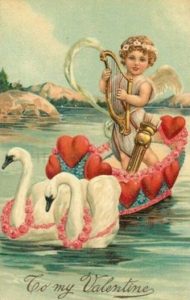It would be easy to think of Valentine’s Day, February 14, as another Hallmark invention, designed to sell greeting cards and create annual anguish on people everywhere as they try to find the perfect card for the object of their affections. But, in fact, Valentine’s Day is an ancient festival, the origins of which may be rather unclear, but rest with certainty in the records of history.
The day is named for Saint Valentine, a Christian martyr of the 3rd Century, though, as noted, there is some uncertainty about which of two, possibly three, martyrs named Valentine is the main source of the celebration. One of these died around 270 AD during the reign of emperor Claudius II, and the story surrounding him is that, before he was executed, he healed his jailer’s daughter of blindness. The day before his death, he wrote her a letter which he signed “from your Valentine”. Hence the tradition of signing Valentines with a similar wording.
 Another possible Valentine was said to have secretly married Christian soldiers in the emperor’s army, and against the commands of the emperor, and so is associated with romance and secret love. However, since Christians didn’t join any army before Christianity became the state religion, and as the emperors had no objection to married soldiers, this tradition lacks some credibility.
Another possible Valentine was said to have secretly married Christian soldiers in the emperor’s army, and against the commands of the emperor, and so is associated with romance and secret love. However, since Christians didn’t join any army before Christianity became the state religion, and as the emperors had no objection to married soldiers, this tradition lacks some credibility.
But that there was a Valentine, and that he was gave rise, somehow, to the tradition of Valentine’s Day, is rather more historically supported. Some believe that the Day is a Christianised version of the older Roman festival of Lupercalia, which celebrated the coming of Spring in mid-February each year. However, that theory has been firmly rejected, as there was little in common with the events of Lupercalia and those of Valentine’s Day. Reflecting their ancient Roman origins, Valentines commonly depict Cupid, the Roman god of love, along with hearts, traditionally the seat of emotion. Birds are often included in illustrated cards, as February was thought to have marked the beginning of mating season for birds. Traditional gifts include candy and flowers, particularly red roses, a symbol of beauty and love.
The Venerable Bede, in the “Ecclesiastical History of the English People”, written in the 8th Century, refers to Valentine as an historical character. Bede is a credible writer on history, medicine, poetry, and science, and is lauded as “one of our best-written sources for early English history”.
References of Valentine’s Day go far back in historical and literary records. The Victorians, of course, are often credited with expanding the mythology surrounding the day, but commercially produced Valentine cards date from the late 1700’s. Earlier still, cards and messages on Valentines Day appear from the 1500’s, and Shakespeare referred to the day in Hamlet, when Ophelia says:
“To-morrow is Saint Valentine’s day, All in the morning betime, And I a maid at your window, To be your Valentine.”
It is thought that one of the earliest surviving valentines in English appear to be those in the Paston Letters, written in 1477 by Margery Brewes to her future husband John Paston “my right well-beloved Valentine”. An even earlier reference can be found in Geoffrey Chaucer’s book, “Parliament of Fowls”, in 1382, and in a few other sources from the 14th Century.
Religious relics are a less reliable source of information on history, but relics of Valentine are held in a number of locations, including, oddly enough, in a church in Dublin. It seems that Pope Gregory XVI donated them to the Carmelite order from their previous location in the cemetery of St. Hippolytus in Rome. They are now on display in Whitefriar Street Carmelite Church in Dublin, Ireland, where they have been since the 19th Century.
But all of this is probably irrelevant to those romantics, and under-pressure lovers, as they search for just the right card, just the right wording, to provide their loves with an expression of their love on February 14 every year.
Of course, for those who have already found the love of their lives, every day is Valentine’s Day and there is no need for cards and flowers to prove their love and devotion. Or maybe that’s what they tell their love when they forget to buy a card?
